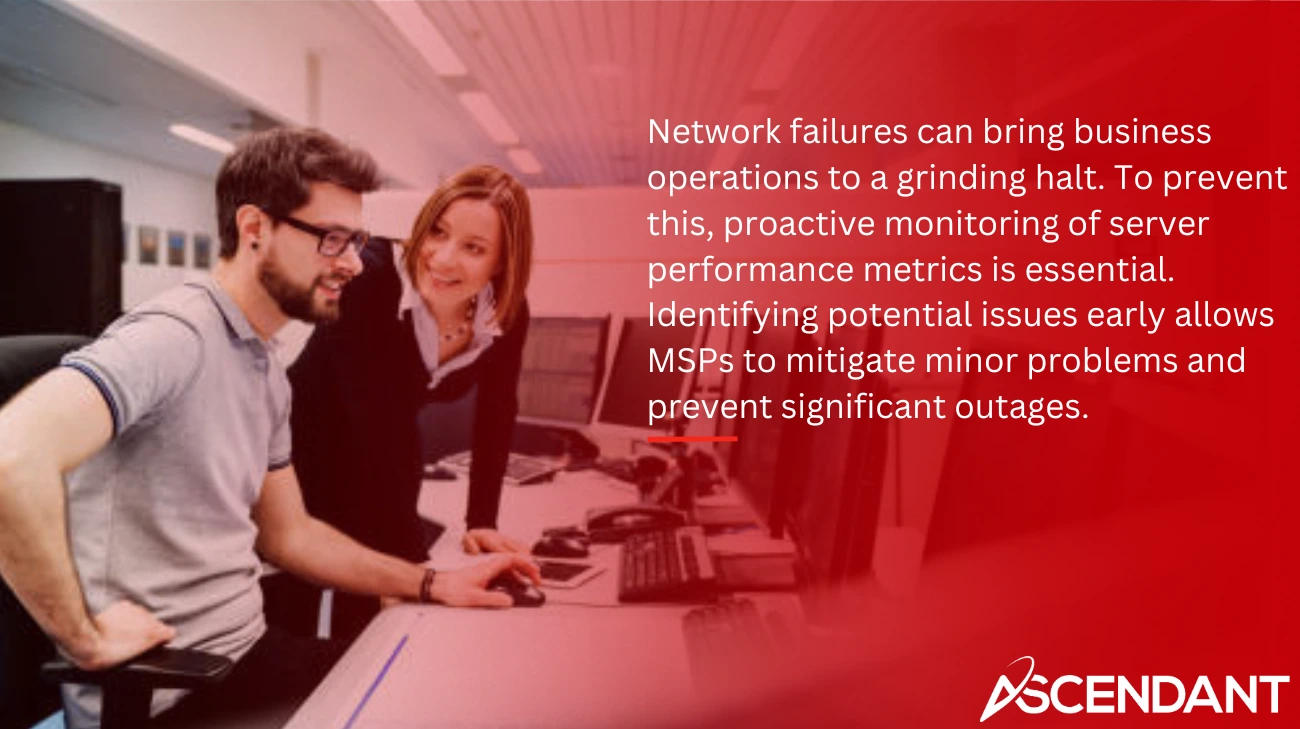What happens when a tech emergency threatens your business operations? Managed Service Providers (MSPs) are equipped to handle these situations quickly and efficiently. This article delves into common tech emergencies MSPs can handle fast, ensuring your business remains operational with minimal disruption.
In This Article:
- Immediate Response to Cybersecurity Breaches
- Rapid Recovery from Data Breaches
- Swift Resolution of Network Failures
- Quick Fixes for Server Crashes
- Fast Recovery from Ransomware Attacks
- Handling Hardware Failures Efficiently
- Rapid Response to Natural Disasters
- Immediate Action on Software Failures
- Quick Resolution of Cloud Service Disruptions
- Efficient Handling of Email Server Outages
- Fast Response to Power Outages
- Rapid Mitigation of Security Vulnerabilities
- Immediate Support for Application Failures
- Quick Resolution of Backup Failures
- Handling Emergency Patching and Updates
Key Takeaways
- MSPs need a swift, multidisciplinary response plan for cybersecurity breaches to minimize downtime and secure data.
- Proactive monitoring and automated systems are essential for rapid recovery from data breaches, network failures, and server crashes.
- Regular testing and maintenance of backup systems are crucial for ensuring quick recovery from disasters and maintaining business continuity.
Immediate Response to Cybersecurity Breaches
When a cybersecurity breach strikes, every second counts. MSPs assemble a specialized team to address various aspects. This multidisciplinary approach ensures that all bases are covered, allowing for a comprehensive and effective response.
Proactive monitoring and management are critical to minimizing downtime during cybersecurity breaches. Vigilant monitoring of incidents allows MSPs to respond swiftly, adhering to defined recovery time objectives (RTOs). Automated response systems further enhance these efforts, executing predefined corrective actions that reduce the impact of breaches swiftly.
A reliable business continuity plan is crucial for protecting important data and resuming operations swiftly. Immediate action in recovery efforts is non-negotiable, as it minimizes the overall impact during such incidents. With a well-oiled disaster recovery plan, MSPs help businesses quickly recover and return to normalcy, safeguarding critical systems and improving security.
Rapid Recovery from Data Breaches
Data breaches are a nightmare for any business, but with the right recovery plan, the damage can be contained. MSPs establish a response team comprising IT, legal, and communications experts to address the data breach effectively. The first step is to secure systems immediately to prevent further unauthorized access.
RTOs and RPOs are vital in disaster recovery planning, defining acceptable downtime and data loss to guide the recovery process. Utilizing cloud-based disaster recovery solutions allows for rapid data restoration, minimizing downtime and ensuring business continuity. Regular rehearsals of recovery strategies further improve the chances of meeting RTOs during real incidents.
Communication is key post-breach. Implementing a communication plan helps manage the flow of information to stakeholders, ensuring transparency and trust. Notifying affected individuals with clear information on how their data was compromised and the steps being taken to protect them is essential.
Regular testing of backup and recovery restorations ensures that recovery processes function correctly in an emergency, enabling businesses to quickly recover and resume operations while meeting their recovery time objective. These disaster recovery tests should be regularly tested to recover data.
Swift Resolution of Network Failures

Network failures can bring business operations to a grinding halt. To prevent this, proactive monitoring of server performance metrics is essential. Identifying potential issues early allows MSPs to mitigate minor problems and prevent significant outages.
Real-time network traffic analysis enables immediate detection of network performance issues, allowing for optimization opportunities. Automated response systems further reduce resolution times by executing predefined corrective actions, improving overall response time. Centralized logging consolidates data from various sources, streamlining troubleshooting and enhancing incident response.
This comprehensive monitoring approach ensures that critical network components are always in check, avoiding blind spots that could obscure the root causes of failures.
Quick Fixes for Server Crashes
Server crashes can be devastating, but with the right backup solutions aligned with recovery time objectives, the impact can be minimized. Investing in uninterruptible power supplies (UPS) provides immediate backup power for critical systems, ensuring that operations continue smoothly even during server crashes.
Standby generators are another crucial component. They sustain essential operations during prolonged power outages but require regular upkeep to ensure reliability. Regular maintenance and testing of these systems are vital to prevent unexpected failures and minimize downtime.
Backup solutions aligned with RTOs meet recovery time standards, avoiding system failures and enabling quick recovery from server crashes. With these measures in place, MSPs can ensure that clients’ critical systems remain operational, safeguarding business continuity and providing a reliable backup solution while also considering the recovery objectives and the recovery point objective.
Fast Recovery from Ransomware Attacks
Ransomware attacks are increasingly common, and MSPs must be able to recover from these threats immediately to minimize downtime and restore operations. Creating tiers in disaster recovery prioritizes high-priority systems for near-instant failover, ensuring critical processes can be restored quickly.
The integrity of backups is paramount. Securely storing backups and protecting them from unauthorized modifications safeguards data integrity. This approach not only facilitates a swift recovery but also helps in improving security against future attacks.
With a robust disaster recovery plan, businesses can quickly recover from ransomware incidents, minimizing lost revenue and operational disruptions.
Handling Hardware Failures Efficiently
Hardware failures are a common cause of downtime, but redundant systems serve as insurance against such failures in disaster recovery planning. Regular audits to identify single points of failure are essential, as physical hardware failures account for about 30% of backup failures.
Addressing these vulnerabilities ensures that backup procedures run smoothly, minimizing the impact on business operations. Regular testing and maintenance of hardware components prevent unexpected failures and ensure business continuity.
Rapid Response to Natural Disasters
Natural disasters can strike without warning, and MSPs must be prepared to respond effectively to an actual disaster. Key preparedness actions include:
- Conducting readiness drills yearly to ensure smooth handling of emergencies.
- Partnering with IT providers to enhance disaster recovery planning.
- Ensuring data integrity during outages through effective planning, including simulated disaster scenarios.
Communication plays a crucial role in the recovery process. Clear communication strategies before, during, and after disasters are essential for coordination. MSPs often establish self-sufficient base camps in severely impacted areas to avoid straining local resources during recovery efforts.
Weather intelligence services provided by a managed service provider help anticipate and mitigate risks to infrastructure during disasters. With dedicated teams ready to deploy quickly, MSP ensures that businesses can quickly recover and resume operations, maintaining business continuity even when disaster strikes. This MSP offering enhances the overall resilience of businesses.
Immediate Action on Software Failures
Software failures can have a significant impact on business operations. Measuring these failures is essential for understanding their impact and improving responses. Creating a blameless postmortem environment fosters learning from software failures without assigning fault, which is critical for continuous improvement.
Rapid support for application failures is essential, as even short downtimes can lead to significant business losses. Software issues can prevent backups from running as scheduled, often without any notifications to the user. Promptly addressing software issues minimizes downtime and ensures business continuity.
Quick Resolution of Cloud Service Disruptions
Cloud service disruptions can be highly disruptive, but real-time monitoring tools allow MSPs to detect and respond swiftly, minimizing downtime for their clients. A clear disaster response protocol helps organizations promptly identify and contain threats to cloud services.

Diversifying IT infrastructure across multiple cloud service providers can reduce the risks associated with relying on a single vendor. Scalability of cloud storage allows organizations to adjust their backup needs based on fluctuating data requirements without significant investment in physical infrastructure.
This approach ensures minimal disruption and helps clients quickly recover while aiming to minimize disruptions from cloud service disruptions.
Efficient Handling of Email Server Outages
Email server outages can cripple communication but implementing scheduled maintenance during off-peak standard hours after hours helps reduce unexpected downtimes. An experienced partner for email migrations in house significantly reduces downtime and improves system performance.
These strategies ensure that email services are reliable and disruptions are minimized.
Fast Response to Power Outages
Power outages are a significant cause of unexpected downtime, impacting business operations. Implementing a Smart UPS can provide reliable backup power to support critical systems during power outages. A comprehensive risk assessment helps businesses identify critical operations vulnerable to power disruptions.
MSPs recommend implementing two internet sources with automatic fail-over hardware to avoid downtime during internet outages. This dual-source approach ensures that businesses can:
- Continue operations smoothly, even when one source fails
- Address power and internet vulnerabilities
- Minimize downtime
- Ensure business continuity
Rapid Mitigation of Security Vulnerabilities
Rapidly securing systems and addressing vulnerabilities is essential to prevent further breaches from occurring. Tools and capabilities that help MSPs manage vulnerabilities include:
- CVSS scoring, which helps prioritize vulnerabilities based on their potential impact and likelihood of being exploited.
- Automated remediation capabilities, allowing MSPs to correct vulnerabilities in real-time and enhance security response times while also helping to identify potential threats.
- Continuous monitoring after remediation, essential to detect new vulnerabilities and ensure lasting security.
Documentation of incidents is vital, as it preserves evidence for forensic analysis and aids in recovery efforts. Testing patches in a controlled environment before deployment can prevent system disruptions. With these measures, MSPs can improve security and minimize downtime, supported by comprehensive documentation.
Immediate Support for Application Failures
Application failures can disrupt business operations significantly. 24/7 availability of IT support ensures that application issues can be addressed immediately, minimizing disruption to business operations. Effective recovery strategies include reimaging and repairing affected applications promptly to restore functionality.
Utilizing remote support tools can expedite troubleshooting processes for application failures, reducing the need for onsite visits. Post-incident assessments help identify vulnerabilities in applications, allowing for improved resilience against future failures. These strategies ensure that client operations continue smoothly and business continuity is maintained.
Quick Resolution of Backup Failures
Backup failures can jeopardize critical data, but MSPs can swiftly address these issues to ensure important data is protected. Data can be backed up in the following ways:
- Automatically from workstations to external hard drives
- Automatically to the cloud
- Using image-based backups stored securely in the cloud, which facilitate recovery from more wide-ranging disasters.
A complete data backup system combines locally redundant drives and image-based backups stored in the cloud. With these solutions, MSPs ensure that recovery processes are in place, allowing businesses to quickly recover and resume operations when disaster strikes.
Handling Emergency Patching and Updates
Timely application of patches is critical for minimizing the risk of exploits targeting known vulnerabilities. Emergency updates should be prioritized based on the severity of the vulnerabilities they address.
Efficiently handling emergency patching and updates ensures systems remain secure and downtime is minimized.
Summary
In conclusion, MSPs play a crucial role in ensuring business continuity through rapid response and disaster recovery planning. From cybersecurity and data breaches to natural disasters and hardware failures, MSPs have the expertise and tools to handle a wide range of emergencies swiftly and efficiently.
By implementing proactive monitoring, automated response systems, and comprehensive backup solutions, MSPs can minimize downtime and protect critical systems. Regular testing and maintenance further enhance these efforts, ensuring that businesses can quickly recover and resume operations. In today’s fast-paced digital landscape, the importance of preparedness and resilience cannot be overstated.
 Frequently Asked Questions
Frequently Asked Questions
How quickly can MSPs respond to a cybersecurity breach?
MSPs can respond to cybersecurity breaches almost immediately by mobilizing specialized teams and leveraging automated systems, helping to minimize downtime and secure your systems quickly. It’s crucial to have that rapid response ready to protect your business.
What steps are involved in recovering from a data breach?
To effectively recover from a data breach, you need to secure your systems, inform all relevant stakeholders, and put recovery strategies in place while regularly testing your backups to ensure they’re reliable. Taking these steps helps you restore trust and security in your data management.
How do MSPs handle network failures?
MSPs tackle network failures by using proactive monitoring and real-time traffic analysis to quickly identify and address issues before they become major problems. Their automated response systems take predefined actions to keep everything running smoothly.
What measures do MSPs take to ensure quick recovery from ransomware attacks?
MSPs focus on high-priority systems for quick failover and secure backups, along with a solid disaster recovery plan to swiftly bounce back from ransomware attacks and reduce revenue loss. Taking these steps ensures a faster and more effective response when disaster strikes.
How do MSPs address backup failures?
MSPs tackle backup failures by implementing automatic and image-based backups that are securely stored in the cloud, along with a robust system that combines local and cloud storage. This multi-layered approach ensures your data is safe and easily recoverable.

